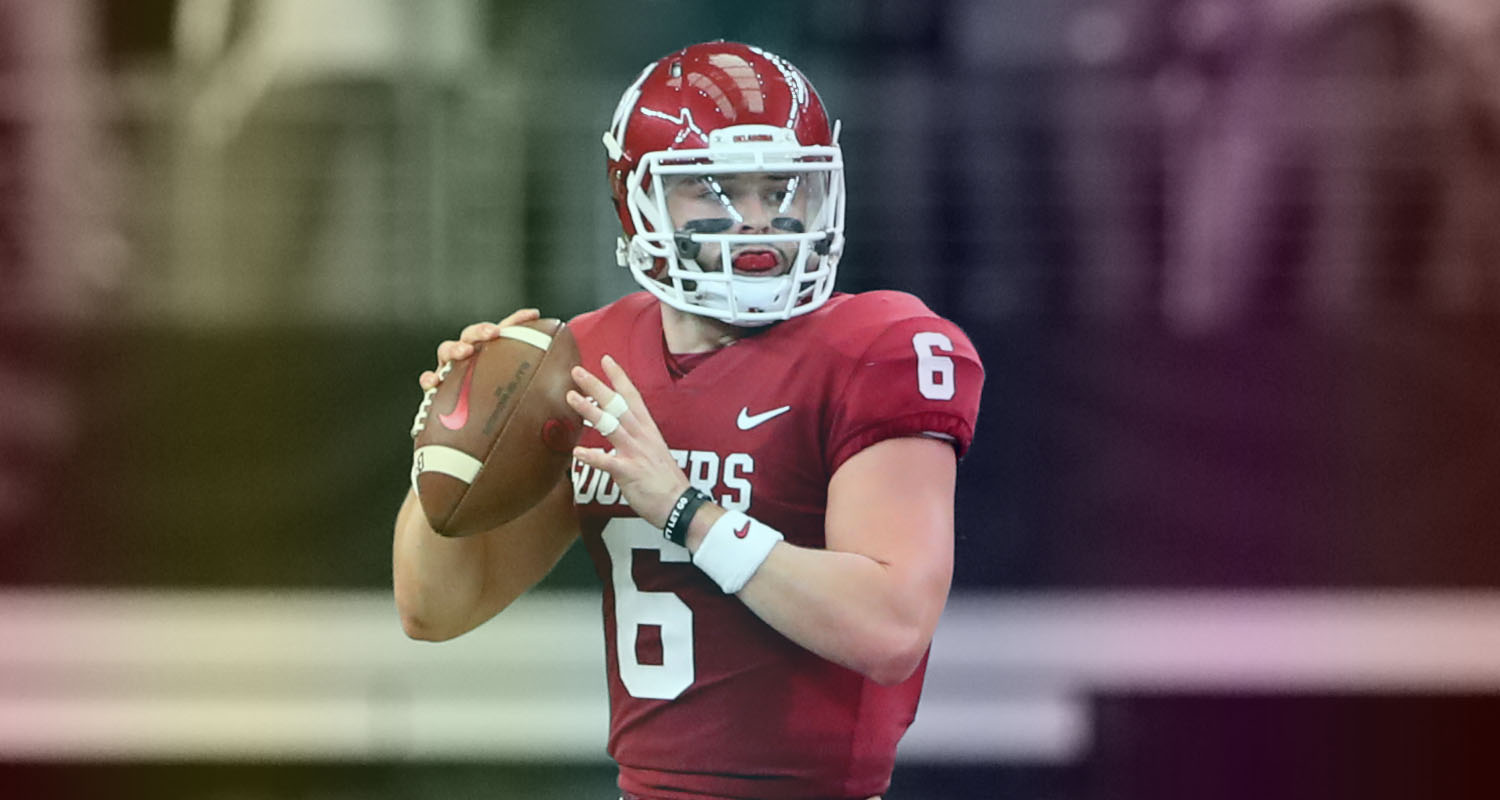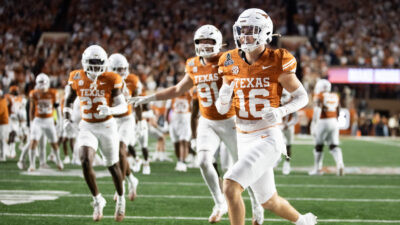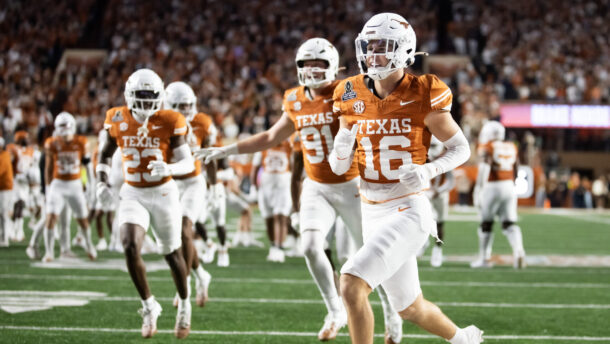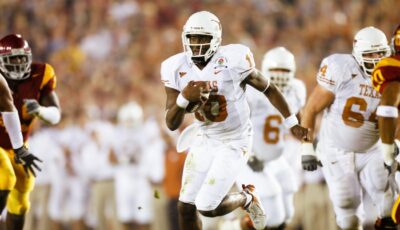
First Look: The least SEC fans should know about Oklahoma, a finely tuned offensive machine
By Matt Hinton
Published:
The Playoff field is set, and the first order of business for SEC fans is to get up to speed on the opposition. First up, our primer on Georgia’s opponent in the Rose Bowl: Oklahoma.
1. Baker Mayfield is on fire. The Sooners’ starting quarterback needs no introduction. On Monday, Mayfield was announced as one of three finalists for the Heisman, officially making him just the seventh player in history to finish among the top five in Heisman voting in three seasons; on Saturday, he’ll take the trophy home for the first time, cementing one of the most decorated college careers ever. A national championship would permanently engrave his name among the all-time greats.
Statistically, he’s already there — this season alone, Mayfield’s pass efficiency rating (203.8) is nearly 20 points better than any other FBS quarterback, and puts him on pace to break the single-season record (196.4) that he set himself last year; at 11.8 yards per attempt, he’s also on pace to break the single-season record (11.4) held by Michael Vick. The career efficiency record, held by OU’s Sam Bradford, is Mayfield’s for the taking. Besides efficiency, he enters the bowls season as the national leader in completion percentage (71.0), passes covering at least 20 yards (75), and total touchdowns (46). He’s well ahead of the pack according to ESPN’s in-house quarterback metric, Total QBR. He’s experienced, mobile, accurate, and for whatever extracurricular angst he may have caused them along the way he hasn’t put Oklahoma fans through anything even remotely resembling a subpar performance.

There are legitimate questions re: the quality of some of the defenses Oklahoma has laid to waste, only two of which (Ohio State and TCU) rank among the top 25 nationally according to Defensive S&P+. But Mayfield’s production against the best teams on the schedule was indistinguishable from his output as a whole; in three games against the Buckeyes and Horned Frogs he averaged more than 11 yards per attempt with 10 touchdown passes and zero picks. In his only career game against an SEC defense, he lit up Auburn for 296 yards and a two TDs en route to a 35-19 win in last year’s Sugar Bowl. Neither Georgia nor Alabama has faced a quarterback of his caliber this year, because in the SEC there aren’t any.
2. The offense is far from a one-man show …: Personnel-wise, the biggest issue Oklahoma faced after last season was a mass exodus at the skill positions: Between them, outgoing RBs Joe Mixon and Samaje Perine and WR Dede Westbrook formed the most prolific trio in the nation in 2016, accounting for nearly two-thirds of the Sooners’ total yards from scrimmage. While it doesn’t boast the same individual star power in Mayfield’s orbit, though, the revamped 2017 edition has turned out to be arguably more explosive.
That’s due largely to three newcomers to the receiving corps, junior-college transfer Marquise Brown, true freshman CeeDee Lamb, and Kentucky transfer Jeff Badet, none of whom qualifies as a headliner but all of whom are home-run threats; along with sophomore Mykel Jones, that group collectively averages an absurd 18.7 yards per catch — much of it coming after the catch — with 17 touchdowns.
The “possession” receivers, tight end Mark Andrews and fullback/H-back Dimitri Flowers, both average more than 15 yards per catch and were just voted first-team All-Big 12 for the second year in a row. Opposing defenses have to account for the fact that on a given play all four or five receivers are legitimate threats.
Another tough look for Tre here as his cousin Dimitri Flowers puts a move on him to get open for the score #okstate pic.twitter.com/spYGCMvsAt
— Dustin Ragusa (@DustRagu) November 5, 2017
3. … and even further from one-dimensional. Still, it would be a serious mistake to lump Oklahoma’s offense in with the kind of pass-happy, Air Raid-style attacks that many fans (especially salt-of-the-earth SEC fans) have come to associate with the Big 12.
Coach Lincoln Riley comes out of that tradition, having played and coached for Mike Leach during the peak Air Raid years at Texas Tech, but in fact the Sooners have been much more balanced this season in terms of both quantity (they keep it on the ground about 55 percent of the time) and quality: OU leads the Big 12 in both rushing offense and yards per carry and ranks No. 1 nationally in Offensive Rushing S&P+ by a wide margin, even without producing an individual 1,000-yard rusher – together, the top three backs, Rodney Anderson, Trey Sermon and Abdul Adams, piled up 2,212 yards on 6.5 per carry without any of them claiming the spotlight. The offensive line, which returned all five starters from 2016, ranks No. 2 in Adjusted Line Yards.
The are serious new questions this week about the status of the leading rusher, Rodney Anderson, who was accused on Monday of raping a woman last month. The woman sought a restraining order against Anderson, but as of this writing he is not facing charges; Anderson’s attorney called the allegation “patently false.” There’s been no update on his status from Oklahoma, which has only said that it’s aware of the situation and gathering information.
4. The defense is anyone’s guess. Based strictly on its highly flammable reputation, the D is probably better than it gets credit for. On occasion it’s been legitimately good, in fact, holding Ohio State to a season-low 16 points in Columbus and TCU to a combined 37 points in the Sooners’ two wins over the Frogs. (In its other 11 games TCU averaged 36 points.) Three defensive starters were first- or second-team All-Big 12, including edge rusher Ogbonnia “Obo” Okoronkwo, who was the conference’s co-Defensive Player of the Year.

But yes, the lapses have been severe. In its only loss, at Iowa State, Oklahoma blew a 24-10 lead by allowing the Cyclones to score on each of their final five offensive possessions, including three consecutive touchdown drives to close the game that covered 94, 73, and 75 yards, respectively; worse, that game marked the first career start for ISU quarterback Kyle Kempt, a former walk-on who torched the Sooners for 343 yards and three TDs on 14.3 yards per attempt. (Kempt didn’t come close to replicating that performance over the second half the season.)
The previous week, OU allowed 41 points on 523 yards of total offense to lowly Baylor, both season highs for the Bears against an FBS opponent. The Sooners gave up more yards to Texas (428) than any of the Longhorns’ subsequent six opponents to close the year and made no pretense of stopping Oklahoma State in a game that infamously featured 1,446 yards of total offense, 62 first downs, 15 touchdowns, and just four punts.
All told, the defense’s standing in the national rankings — 57th in total defense, 62nd in scoring, a dismal 95th in Defensive S&P+ — is probably a roughly accurate description of its actual performance. It has the potential to be a lot better than that, and in spots it has been. But for a Playoff team, the fact that it’s just as often been worse is a the single biggest concern.
5. Lincoln Riley is ahead of schedule. As a rule, first-year head coaches don’t win national championships. In the BCS/Playoff era, multiple coaches have won it all in Year 2 (Bob Stoops, Jim Tressel, Gene Chizik, Urban Meyer at Florida) and Year 3 (Pete Carroll, Nick Saban, Les Miles, Urban Meyer at Ohio State), but only one has claimed the biggest prize right out of the gate: Miami’s Larry Coker, in 2001, after inheriting the most stacked roster in modern college football history from the NFL-bound Butch Davis. Only one other first-year head coach in that span, Auburn’s Gus Malzahn in 2013, has made it as far as the championship game.
Riley inherited a talented roster at Oklahoma, of course, but needless to say it is not turn-of-the-century Miami Hurricanes talented. After he was promoted to replace Stoops in June — with just two years under his belt as OU’s offensive coordinator, a rapid ascent by any standard — Oklahoma opened at No. 7 in the preseason AP poll, where it started out more often than not under Stoops in the top five.
Despite pegging them as near-unanimous favorites to win the Big 12, no major outlet saw Riley’s Sooners as a likely Playoff team. Even if they fail to advance, their presence in the final four is a good indication that their precocious coach is going to be a familiar face on the sport’s biggest stages for years to come.
And for the record, yes, Riley is also ahead of the curve in terms of his age: At 34, he’s is aiming to become the youngest head coach (by far) to win a national championship since Danny Ford, who was just 33 when he led Clemson to its first title in 1981. That was two years before Riley was born.
Matt Hinton, author of 'Monday Down South' and our resident QB guru, has previously written for Dr. Saturday, CBS and Grantland.







